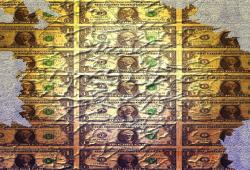
Two important bodies have sent out voices of caution on the Indian economy in recent days. The International Monetary Fund (IMF) has revised its growth estimate downward for India, for this year as well as the next. The revision is small for 2018, from 7.4 to 7.3 per cent. But for next year, the revised growth projection is down from 7.8 to 7.5 per cent. The question is not about how accurate the forecasts of the IMF are, but rather the reasons for the downward revision. Separately, in its annual report on the budgets of State governments, the RBI pointed out earlier this month that the aggregate State finances have exceeded the fiscal deficit target of 3 per cent of GDP for three years in a row. In fact, for the fiscal year ending March 2018, the fiscal deficit target was 2.7 per cent and actual was 3.1 per cent. This tells us that State finances seen as a whole are not in very good health. Mind you that already last year’s growth of 6.7 percent was the lowest in the past four years.
The chief culprit is oil, which also impacts the cost of logistics and transportation. India is very vulnerable to oil price shocks, and a spike in oil affects inflation, trade balance and fiscal burden adversely. It also has a negative effect on aggregate demand and hence economic growth. There is not much that can be done in case oil shoots up.
Coming around the same time, the two reports serve to highlight macroeconomic concerns as we head into an election year. Consider some of the challenges. The Consumer Price Index (CPI)-based inflation is now at 5 per cent. This is already showing an upward momentum, especially in non-food prices, which include education and medical expenses, and other services. More worryingly, the inflation based on the Wholesale Price Index (WPI) was 5.77 percent in June, which is the highest in four years. This was caused by higher commodity prices which are inputs to industrial production. The chief culprit is oil, which also impacts the cost of logistics and transportation. Oil prices have risen sharply, caused by factors like sanctions on Iran and other geo-political uncertainties. The Reserve Bank of India observed that the price of India’s oil basket has gone up by 12 per cent and looks like this rise is going to last. India is very vulnerable to oil price shocks, and a spike in oil affects inflation, trade balance and fiscal burden adversely. It also has a negative effect on aggregate demand and hence economic growth. There is not much that can be done in case oil shoots up.
A critical factor is fiscal deficit, on which the Central government has succeeded in keeping some control but the States’ have not. This is well pointed out by the RBI study on State finances. Further, this year many States have announced loan waivers, with the latest to join the club being the State of Karnataka. This may be justified on political grounds, or an inevitable response to farm distress. But the net result is owing to various pressures, populist or otherwise, the combined fiscal deficit of States and Centre during this fiscal year could be as high at 6.8 or even 7 percent of GDP. This would be a multi-year high, causing worries about its impact on inflation, interest rates, foreign investment sentiment and country rating. Please keep in mind that national elections are due next year, which can mean additional spending pressure. The recent revision of GST rates while providing welcome relief would however affect collections negatively, at least in the short run. The increase in farm procurement prices (MSP) too is welcome but has a fiscal cost. Same is the impact of a hike in sugarcane and milk procurement prices. Thus, meeting the fiscal targets this year is a bigger challenge. The States’ fiscal deficit target is 2.6 percent, which is even more difficult to achieve.
The other headwind comes from the current account deficit. India’s exports have stagnated for the past four years in cumulative terms. The exports at the end of March 2018 are lower than four years ago. In the recent past, exports have risen in double digit growth rates, but its sustenance needs to be watched. There are many problems that afflict exporters, such as a strong exchange rate, delays in GST refunds, higher logistics and infrastructure costs, overall burden of taxation, and cost of compliance especially at the local and State government level. A stark example is in the garment industry, where India has been overtaken even by Bangladesh and Vietnam, even in absolute dollar terms. Apart from export challenges, imports continue to surge, especially in metals, chemicals, electronics and consumer goods. India’s number two contributor to the current account deficit is not gold, but electronics goods, which include mobile phones.
Driving through these challenges will require deft macroeconomic management, clever fiscal cost control, assuaging anxieties of the stock and bond markets, keeping the confidence of the foreign investment flows and keeping the rupee stable and fairly priced.
This year, India will import close to 200 million tons of coal despite being the third largest depository of coal in the world. The outward flow of dollars for pursuit of foreign education is higher than 10 billion dollars annually. The various free trade agreements are now reaching a stage where many goods have virtually duty-free entry to India’s large consumer market, when domestic industry continues to face disability of higher costs and import duties for their intermediate goods. The current account deficit this year could reach between 2.5 to 2.8 percent of GDP, the highest in many years. This will cause a weakening pressure on the exchange rate, making imports like oil and electronics even more expensive.
Since inflation is rising, and the monetary policy is focused on keeping it in the band of 2 to 6 per cent, naturally interest rates are headed upwards. The RBI raised its policy rate in June, for the first time in four and a half years. But it was already behind the curve, since the market had signalled its expectations. The yield on the 10-year government bond, had risen by more than 1.5 percentage points in the previous twelve months. It is almost certain, given the worries on inflation and oil prices, as also fiscal deficits, that the RBI will raise interest rates in the coming months. This has an adverse macro impact since it transmits as higher cost to home loans, infrastructure and real estate finance as also other consumer loans. Not to mention the burden on working capital costs for small and medium enterprises.
Driving through these challenges will require deft macroeconomic management, clever fiscal cost control, assuaging anxieties of the stock and bond markets, keeping the confidence of the foreign investment flows and keeping the rupee stable and fairly priced. Plus giving a boost to consumer sentiment as well. It’s going to keep the policy makers quite busy.
(The writer is an economist and Senior Fellow, Takshashila Institution)







